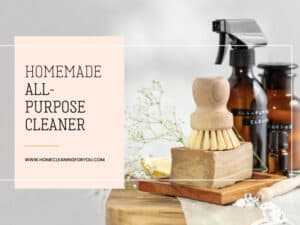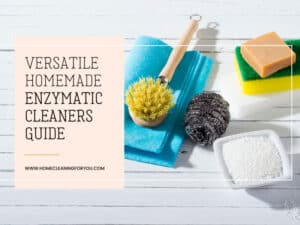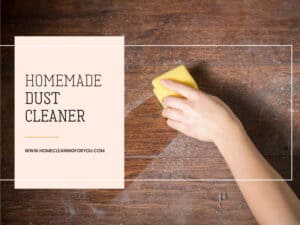Guide to Make Homemade Deck Cleaner Solutions
Homemade deck cleaner is an economical method to preserve your platform’s aesthetic look without compromising nearby plants.
If you notice closely, you will realize that the outdoor deck encounters a great deal of traffic daily. Such contaminants include spilled food, muddy shoes, and all the dirty, smelly mess that your wet pets cause. Besides, your deck also faces other elements, such as leaves and algae.
Despite all those negative factors, cleaning your deck does not demand any expensive and tough deck detergent. Instead, all you need is 30 minutes to build your own eco-friendly homemade deck cleaner, and apply it using a deck brush. All dirt and grime will disappear instantly.
Six Common Deck Types Based On Material

Before diving into the world of homemade deck cleaner, it is essential to have some fundamental knowledge about different types of deck. In this section, I will show you six common deck types based on material.
1. Pressure-Treated Wooden Deck
Let’s start with the most affordable option. Pressure-treated wooden decks are made of fir and permeated with insecticide and anti-rot agents. Before 2004, the anti-rot procedure was extremely toxic as it included arsenic, posing serious health concerns if burned. However, this process is safer and relies on less toxic substances.
The overall color of pressure-treated wooden deck is brown and tan, which is not a desirable appearance. You can improve this flaw by applying stain on the deck.
This deck type can survive for decades if it is refinished with stain or sealant on an annual basis.
2. Cedar Deck
If you prefer the natural beauty of real wood, you should check out the cedar deck. Cedar is a perennial plant whose wood is affordable and easy to manipulate. Therefore, it is an ideal choice for DIYers.
My advice is to pick the cedal with darker-looked heartwood, as it is the most durable type in its category. This deck type can last up to 20 years, should you refinish it annually.
3. Redwood Deck
All I can describe about redwood deck is that it is lightweight, durable, and simple to work with. This rot-resistant material is widely available on the West Coast, so that is a good news for this area’s residents.
Choose the redwood lumber with little cream-colored sapwood and dark-colored heartwood for higher durability. With careful maintenance, the material can last up to 20 years.
4. Vinyl Deck
Do you believe there is a deck type that is maintenance-free? You should, because I am going to deliberate about the polyvinyl chloride (PVC) deck. This deck type contains literally no wood. Some high-end varieties may have a cellular core wrapped with an external PVC layer.
With vinyl deck type, you have a wide range of color options, including brown, grey, tan, and white.
5. Composite Deck
The following deck type comprises wood fiber and recycled polyethylene. It possesses an aesthetic appearance with low requirement for maintenance.
Composite deck is available in many colors and textures that resemble closely to real woods. Thus, this deck type’s design is extremely versatile. Furthermore, it can also be bent via the utilization of heating planks to make attractive in-laid structures.
Despite a low demand for maintenance, its wood content can introduce mold if the deck is not rinsed with water for every 3 – 4 years.
6. Ipe Deck
Ipe deck is the top choice for its aesthetic, rot resistance and durability. However, ipe is massively tough, making its assembly very labor-intensive. Your ipe deck can last over 25 years if you apply sealant on it annually.
Must-Know Safety Precautions Before Building Homemade Deck Cleaner

Safety is always the top priority. This principle applies to mixing up your own homemade deck cleaner as well. Here are some safety notes that you should pay great attention to.
1. Building A Homemade Deck Cleaner Unharmed For Plants
Nobody would trade a clean deck for dead plants in its surrounding areas. The application of toxic and strong chemicals on an outdoor platform can seriously poison grass and plantings. Therefore, the top advice is to rely on non-toxic ingredients only.
One recommendation is OxiClean. The item is perfectly safe for eradicating a wide array of stains and spills at different levels, as it contains sodium percarbonate and a hydrogen peroxide derivative. On top of that, it is biodegradable and safe for the environment.
You can rest assured that no nearby plants are harmed during your use of this particular product.
2. Careful When Co-Using Homemade Deck Cleaner With Pressure Washer Or Power Washer
Pressure washers and power washers comprise tiny nozzles that can generate massive water pressure. Hence, there is a high chance that your homemade deck cleaner will clog the nozzle, due to their granular structure that is unable to dissolve completely.
Indeed, high water pressure is redundant in cleaning your deck. The active ingredients in your DIY deck cleaning recipe are sufficient to do all the work. By that I mean, a typical garden hose is more than enough to rinse away the cleaner.
However, for larger decks, consider using a pressure washer to save time.
3. Utilizing Gloves When Mixing The Cleaner To Protect Your Hands
You may encounter skin irritation upon contacting directly with boosting agents and cleaners via bare hands. Despite being non-toxic, it is always advised to equip yourself with a pair of rubber gloves when building and applying your own homemade deck cleaner.
In case the solution splashes and gets on your skin, just calmly wash them off with water.
4. Saying No To Mixing Ammonia-Based Substances With Bleach
Not all chemical combinations are safe to perform, especially in case of ammonia and bleach. Mixing these two ingredients will generate toxic chloramine gas that is extremely harmful to your eyes, mouth, and respiratory system. Therefore, never conduct any combination between them.
5. Let The Blech-Based Solution To Dry Completely Before Applying Treatments
You should only perform extra treatments for your outdoor platform (staining, painting, sealing) when the deck is completely dry. This precaution is necessary for preventing the blech elements from reacting with other substances.
Another good approach is to wait until your deck dries before undergoing deck repairs like reinforcing deck boards or replacing rusty screws.
6. Preparing A Well-Ventilated Storage For Your Homemade Deck Cleaner
Although your homemade deck cleaner is free from toxic substances, it still creates odor. Therefore, a well-ventilated storage is very much needed for such DIY solutions.
Moreover, since the cleaner is designed for outdoor uses, keep it outdoors until applying it to clean your platform and then dispose of any remaining. Utilize a brand new batch every time you clean the deck.
7. Keeping Your Homemade Deck Cleaner Out Of Children’s Reach
Nothing beats the curiosity of children. A bucket of warm solution is no exception. In fact, it is extremely appealing to kids, as they think this is unlike any other toys.
Therefore, although this homemade deck cleaner is mild, it is still somewhat a cleaner and thus should be kept out of the reach of children.
Best Homemade Deck Cleaner Recipes
Before reading this article, you may think that it is more convenient and efficient to grab the specialized deck cleaning solution in the aisle of a grocery store. That is not necessarily true. It is indeed easy and time-saving to formulate your own homemade deck cleaner. Sounds difficult to believe, right? Let’s try these following concoctions for yourself.
Recipe #1: Use TSP And Bleach

My first homemade deck cleaner recipe is dedicated to eradicating algae, mold and mildew on your outdoor platform. These two annoyances are commonly spotted in areas with elevated moisture levels. Things might get more severe if your deck is covered in shaded footprints.
So, to formulate this concoction, you will need these below mold and mildew killers:
- Powdered oxygen bleach (available in various grocery stores).
- Trisodium phosphate (aka. TSP).
- Warm water.
To start off, remember this rule: for every two gallons of warm water (7.6 litres), you will utilize 1.5 cups of TSP and 1 cup of bleach. It is important to buy powdered oxygen bleach, as other bleach types (liquid chlorine) can harm your platform.
The next step is to rinse your deck using a garden hose. Without this step, you will have a challenging time cleaning the deck. So, make sure to soak it with water.
After that, attach a scrub brush to any long handle and use this tool to clean the deck. The long handle is important, as you can do the job without touching your hands or knees directly to the bleach – TSP solution.
Moreover, make sure to hold your breath while scrubbing, as the fumes generated from the mixture is quite toxic.
After sweeping over the entire deck, wait at least 15 minutes to let the stains go away before washing the wood again with water. There you go, a whole new deck that is free from algae, mold, and mildew.
If dirts and stains persist, you can simply repeat the process until you achieve a satisfactory result. Do not try to add in more TSP or bleach to form a stronger cleaning solution.
If you are looking for some visual tutorials, you should have a look at the following video:
Recipe #2: Use Detergent And Bleach

If you are not a fan of cleaning decks on a regular basis, you definitely need this upcoming recipe. You can apply this next combination for your platform once or twice a year and still get a satisfactory result.
Gather these elements for a successful mixture:
- Powdered oxygen bleach.
- Liquid dish detergent.
- Warm water.
Get yourself two gallons of water. Add in 1/4 cup of dish detergent and 2 cups of bleach. Mix the solution nicely. Then, utilize a large brush (or a broom) to spread the newly-made concoction through the entire platform’s surface. Use some additional efforts on hard-to-remove dirts. Finally, rinse the deck using water from a garden hose.
The upcoming video will show you some visual evidence about the effectiveness of this concoction, so make sure to check it out:
Recipe #3: Use Oil Soap And Bleach

My next recommendation of homemade deck cleaners is also referred to as the “Kile’s recipe” – the man behind this solution. All I can say is that this solution is easy to mix, affordable, and extremely effective. However, be forewarned to use this mixture with great caution, as its ingredients include liquid bleach, which is detrimental to your deck’s surface.
This mixture requires the following additives:
- Liquid bleach.
- Murphy’s oil soap.
- Warm water.
You will need 1 gallon of water for this solution. Pour in 4 cups (1 quart) of liquid bleach and 2 tablespoons of Murphy’s oil soap into the water. Mix the elements evenly. Then, brush the solution onto your deck’s wooden surface and rinse with warm water thoroughly after that.
One important note is to utilize inexpensive liquid bleach for this mixture, as a high quality one can severely destroy your deck.
Regarding the Murphy product, feel free to switch to other ammonia-free detergents.
Recipe #4: Use White Vinegar

If you spot just a few stains on your wooden platform, you can fine-tune it with this extremely mild solution. Be aware that this next recipe is not as strong and effective as the ones mentioned above. However, it is perfectly fine when dealing with oily stains and grime. Plus, it is completely safe for surrounding plants.
As the name infers, you will only need two simple ingredients for this recipe:
- White vinegar.
- Warm water.
Pour 1 cup of white vinegar into 1 gallon of warm water. Mix it up gently. After that, use a paint brush to cover only those small areas containing stains and dirt. This method is beneficial and removes all the hassle of using a sprayer or a pressure washer.
All you need to do now is wait for the spots to dry, and clean them off with water afterward.
Recipe #5: Use Baking Soda And White Vinegar

When it comes to cleaning, baking soda is the most effective ingredient that you can confidently rely on. Deck cleaning is no exception.
For making this recipe, you will need these following items:
- Baking soda.
- White vinegar.
- Warm water
The simplest applied method is to spread some baking soda on the platform’s wooden surface. Then, spray white vinegar on top of that and start scrubbing the deck with a brush. Finally, wash everything with water.
This method is clearly illustrated in the upcoming video that you should check out: How to clean your deck or patio with vinegar and baking soda, environmentally and pet safe.
Recipe #6: Use Laundry Detergent Powder And Bleach

If you spot certain grease stains lying on the platform’s surface, you can turn to laundry detergent powder for assistance. It functions exactly the same way as you clean grease stains from your clothes.
The ingredient list for this concoction is extremely simple as well. You will need to gather:
- Laundry detergent powder.
- Bleach
- Warm water.
Your first step is to spread the detergent powder and bleach mixture over all the annoying grease stains. Following that, you will use a brush to scrub these spots. The final act is to rinse them with water.
For this recipe, you can replace laundry detergent powder with oxalic acid crystals. The substitution yields equivalent results in cleaning stains on the deck. However, this element must be mixed with water before application (1 tablespoon for a gallon of water).
If you need to see some real actions, feel free to watch the following video:
Comprehensive Tutorial On Applying Homemade Deck Cleaner

Just like every other cleaning procedure, you will need to prepare certain following materials and equipments:
- One large plastic bucket.
- Bleach (usually powdered oxygen bleach).
- A scrub brush.
- A long handle or extensive pole (a broom).
- One putty knife.
- Cleaning solution (detergent, or dishwashing mixture).
- Garden hose.
- A pressure washer (optional, dedicated for larger decks)
- Borax (optional, for removing mildew).
After gathering all the above tools, follow these sequential steps to apply your homemade deck cleaner properly to the platform.
Step #1: Clear Off Your Deck And Soak It With Water
The foremost step of the deck cleaning process is to remove all objects placed on it, such as the grill, gardening containers, and other miscellaneous furnitures. Make sure to stash them somewhere else before you spray the whole surface with water from your garden hose.
But do not touch your garden hose yet! You need to make sure your surface is clean first by sweeping it entirely. Remove all debris that you find. Keep an eye on all the cracks between the boards, as these are the places where debris is stuck. Utilize a putty knife to clear these crevices.
You can go a step further to cover all nearby plants with a plastic sheet, ensuring that no cleaning solution can affect them.
After those initial preparations, it is high time to rinse the deck’s surface with water. Soaking your deck before applying a cleaning solution has two benefits. Firstly, it helps open up the pores of the wood for deeper penetration of the deck cleaner. Secondly, it loosens tough debris and muds, making it less a nightmare to clean.
Step #2: Formulating Your Homemade Deck Cleaner
Fill the plastic bucket with 1 – 2 gallons of water. Then, following one of the aforementioned recipes to mix your own homemade deck cleaner.
One small note is to equip yourself with goggles and rubber gloves for better eyes and skin protection. Don’t underestimate the strength of this solution, although it is very mild.
Step #3: Applying The Deck Cleaning Solution
Dipping the brush into your homemade deck cleaner and start sloshing all over the platform’s wooden surface. Be patient in this step, especially if you are dealing with a sizable deck. Gradually work your way from one end to the other, and rewet the brush when needed.
Instead of a scrub brush, utilizing a pressure washer will save you time tremendously when you deal with larger decks. However, follow the manufacturer’s instructions strictly to avoid any unnecessary damage to your wooden platform.
It is advised to maintain a distance of about two feet between the machine’s nozzle and your deck. Otherwise, the deck cleaning procedure will create a hole on your platform.
After covering your entire deck with the solution, allow it to do its job for at least 15 minutes before moving on to the next step.
Step #4: Washing Off The Deck
This next step is simple. Use your garden hose to rinse the deck once again. After that, let the wooden platform dry naturally under the sunlight before performing any redecoration afterward.
Step #5: Cleaning The Furniture As Well
If algae and mildew are what you are dealing with, do not expect that deck’s surface is the only place they exist. They grow everywhere, and your furniture is no exception.
Therefore, make sure to apply the cleaning solution (Oxiclean and water mixture) on your objects, such as the patio furniture, polyvinyl fences, and pretty much all outdoor surfaces that need a proper cleaning. For wooden objects, you can use certain specialized wood cleaners.
Before putting these items back to their original positions, check your deck again for any remaining stains or dirts. If they still persist, repeat the deck cleaning process on them.
Finally, it is highly advised to apply a sealer to preserve the aesthetic of your deck for longer terms. Then, you can bring all your furniture out again.
Useful Maintenance Tips For Wooden Decks

Cleaning is an essential act that must be carried out to preserve the fresh look of your deck. However, apart from sloshing the platform with homemade deck cleaner, a good practice is to perform regular maintenance via the following tips
1. Eradicating Mildew With Borax
You can add a cup of Borax to your homemade deck cleaner to remove all visible mildew stains on your deck surface. Being a natural compound, Borax is completely safe for surrounding landscaping plants. All the subsequent steps are the same as instructed above.
2. Applying A Penetrating Sealer Annually
Even the tough, pressure-treated decks will gradually succumb to the ruthless UV rays, harsh weather conditions, and heat fluctuations. Therefore, it is highly recommended to treat the wooden platform with a high quality penetrating sealer to achieve more extensive product life. Remember to apply the sealer right after its cleaning.
3. Sweeping Away Debris Swiftly
Daily sweeping to get rid of leaves, dirt, and other debris from your deck’s surface is an extremely good practice. In case you are not a fan of sweeping, you can check out a cordless blower, especially those from Black And Decker. It is lightweight, simple to function and very efficient in removing twigs, dirt, and other natural debris.
Frequently Asked Questions
In this section, you will go through answers for some of the most commonly searched questions about the topic.
Additional Advice On Homemade Deck Cleaner
One additional tip for homemade deck cleaner is to always mix the concoction outside in the well-ventilated area. Read the labels on your bottled chemicals carefully to avoid mixing wrong ingredients with each other. Failing in doing so can generate a very dangerous chemical reaction.
In a nutshell, there are a wide array of recipes for homemade deck cleaner. All of the best formulas are compiled here in my article. Just feel free to refer to them.
That is everything about homemade deck cleaners that I can share with you. Now, it is time I want to hear your voice on this topic. Do you have any unique recipes that you can share? Feel free to drop a comment in the section below.








Kevin Jones
Founder & Chief Home Organization Strategist
Expertise
Home Organization & Decluttering, Efficient Cleaning Methods & Stain Removal, Sustainable Cleaning Practices, DIY Home Maintenance & Repairs, Space Optimization & Storage Solutions, Budget-Friendly Home Care Strategies
Education
University of Texas at Austin
Kevin Jones is the Founder and Chief Home Organization Strategist at HomeCleaningForYou.com.
He earned a Bachelor of Science in Interior Design from the University of Texas at Austin, focusing on space planning and sustainable design. Specializing in home organization, decluttering, and budget-friendly home care, he helps homeowners create functional and stylish spaces.
Kevin has been featured in lifestyle publications and has collaborated with eco-friendly brands on home organization solutions. He shares his expertise through DIY guides, workshops, and online tutorials. Passionate about minimalism, he enjoys testing new organization methods and exploring sustainable living ideas.